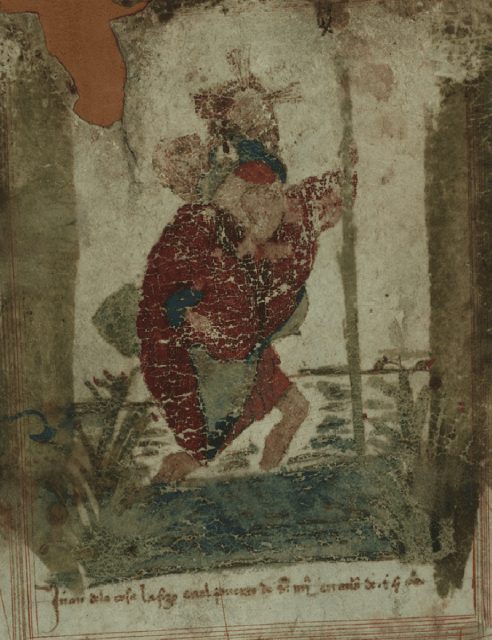Fig. 2.1. St. Christopher
Detail from Juan de la Cosa, Carta Universal, 1500, Museo Naval de Madrid & Biblioteca Virtual del Ministerio de Defensa, Madrid.
This illumination on the western edge of Juan de la Cosa’s Carta Universal has layers of meaning that reveal the quickly changing view of the Atlantic in 1500. The view of St. Christopher carrying the Christ child is positioned over the isthmus of Panama. Under the icon appears La Cosa’s signature: “Juan de la Cosa made it in Puerto de Santa Maria in the year 1500.” La Cosa, or an artist working on the world chart, placed St. Christopher moving past a window, or a doorway, with a horizon in the distance. A window or door is suggested by the way the artist framed the opening, using lies that create perspective. The view beyond can be seen as the way to Asia, the intended destination of Christopher Columbus. To reach Asia, yet another voyage was necessary. The image can be read as a religious statement, that is, as a metaphorical depiction of the arrival of Christianity in the Americas. It can also be read as a representation of Columbus, whose given name was Cristoforo Colombo, which became Cristóbal Colón in Spanish. After returning from his first voyage in 1492, Columbus called himself Xpo Ferens (Xpo=Christ / Ferens=carrying) meaning the Christ child bearer. After 1493, he typically signed with this signature as part of a larger abbreviated seal, as can be seen from a letter dated 1502 from the Archive of the city of Genoa, see below. The S. /S. A. S./ X M Y that appear over Xpo Ferens have never been satisfactorily translated.
Detail of “Manuscrito sobre papel, Sevilha, 21 de março de 1502,” in Arquivo da Cidade de Génova, Itália, available on Wikimedia Commons.

